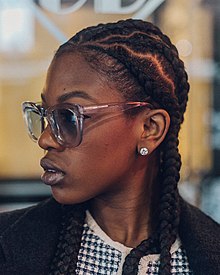
Back Trena africana cosida Catalan Cornrows German Trenza africana cosida Spanish کورنروز Persian Cornrows French Pletenice uz glavu Croatian コーンロウ Japanese Afrofletter NB Cornrows SIMPLE Rastaflätor Swedish

Cornrows (sometimes called canerows) are a style of traditionally three-strand braids, originating in Africa,[1][2][3] in which the hair is braided very close to the scalp, using an underhand, upward motion to make a continuous, raised row. Cornrows are often done in simple, straight lines, as the term implies, but they can also be styled in elaborate geometric or curvilinear designs. They are distinct from, but may resemble, box braids, Dutch braids, melon coiffures, and other forms of plaited hair, and are typically tighter than braids used in other cultures.[4]
The name may refer to the corn fields or sugar cane fields of the Americas and Caribbean.[5][6] According to black folklore, cornrows were often used to communicate on the Underground Railroad and by Benkos Biohó during his time as a slave in Colombia.[7] They often serve as a form of black self-expression.[8] Cornrows are traditionally called "kolese" or "irun didi" in Yoruba, and are often nicknamed "didi braids" in the Nigerian diaspora.[9]
Cornrows are worn by both sexes, and are, on some occasions, adorned with beads, hair cuffs, or cowrie shells. The duration of weaving cornrow braids may take up to five hours, depending on the quantity and width.[10] Often favored for their easy maintenance, cornrows can be left in for weeks at a time if maintained through careful washing of the hair and natural oiling of the scalp. Braids are considered a protective styling on African curly hair as they allow for easy and restorative growth; braids pulled too tightly or worn for longer lengths of time and on different hair types can cause a type of hair loss known as traction alopecia.[11]
- ^ "Cornrow". Dictionary.com. Retrieved 27 February 2024.
- ^ Horne, Madison (28 February 2018). "A Visual History of Iconic Black Hairstyles". History.com.
- ^ "History of Braids: More Than Just a Hairstyle". Genesis Career College. Retrieved 27 February 2024.
- ^ Underwood, Khalea (24 August 2019). "Cornrows, Braids, Twists, Oh My: How To Spot The Difference In Braiding Styles". Refinery29. Retrieved 27 February 2024.
- ^ Charlotte Mensah (29 October 2020). Good Hair: The Essential Guide to Afro, Textured and Curly Hair. Penguin Books Limited. p. 42. ISBN 978-0-241-98817-6.
- ^ "cornrow (noun)". Oxford English Dictionary. Retrieved 27 February 2024.
- ^ Irbahim, Nur (12 March 2022). "Did Braiding Maps in Cornrows Help Black Slaves Escape Slavery?". Snopes. Retrieved 27 February 2024.
- ^ Dash, Paul (31 January 2006). "Black hair culture, politics and change". International Journal of Inclusive Education. 10 (1): 27–37. doi:10.1080/13603110500173183. ISSN 1360-3116.
- ^ Kia, Kara (5 February 2021). "It's Time We Ditch the Words "Cornrows" and "Canerows" and Call Them Didi Braids Instead". POPSUGAR Beauty UK. Retrieved 29 February 2024.
- ^ "Cornrow Braid Styles". Africanamericanhairstyling. Archived from the original on 26 July 2018. Retrieved 11 August 2018.
- ^ "Braiding 'can lead to hair loss'". BBC News. 24 August 2007. Retrieved 30 April 2010.
© MMXXIII Rich X Search. We shall prevail. All rights reserved. Rich X Search